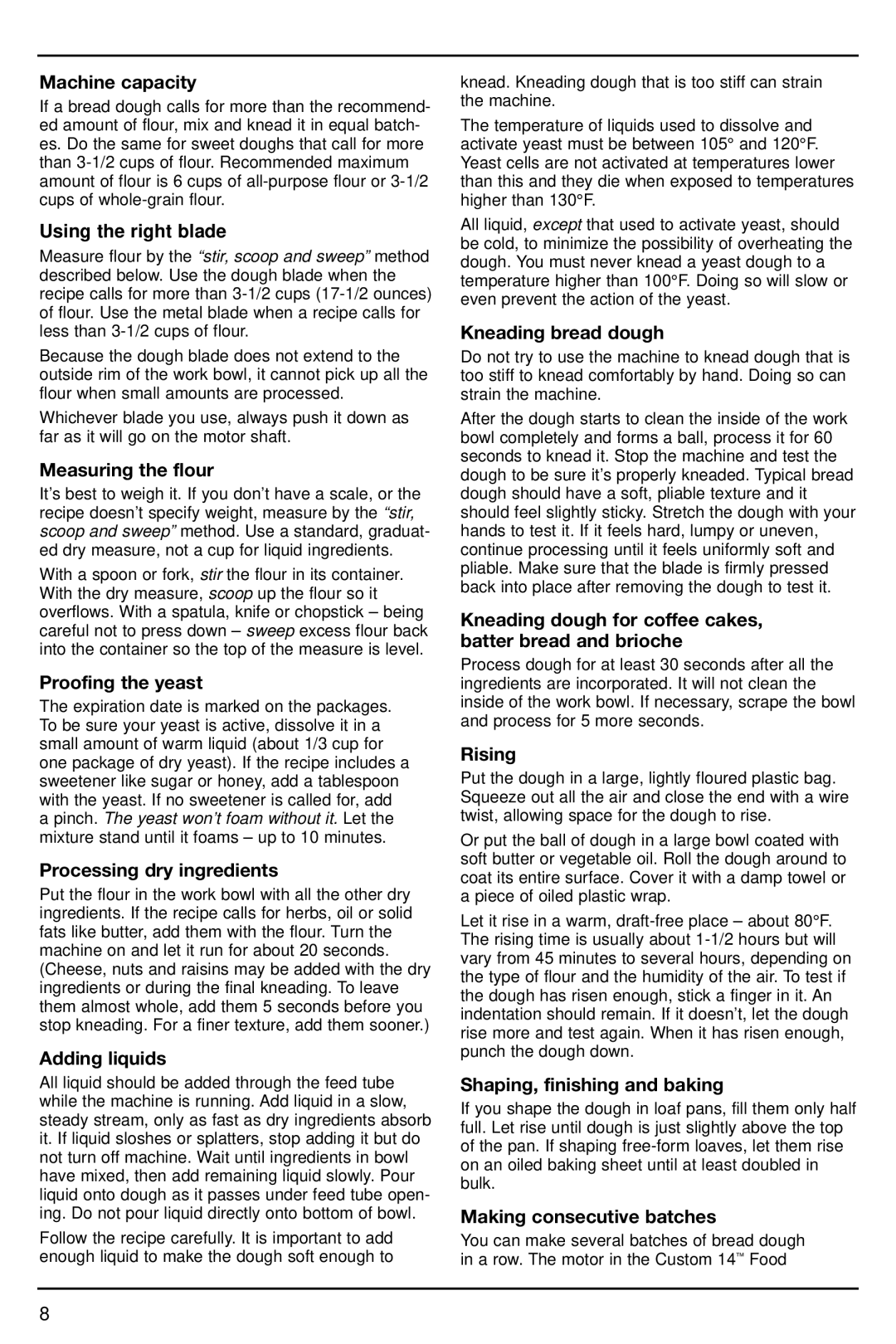Machine capacity
If a bread dough calls for more than the recommend- ed amount of flour, mix and knead it in equal batch- es. Do the same for sweet doughs that call for more than 3-1/2 cups of flour. Recommended maximum amount of flour is 6 cups of all-purpose flour or 3-1/2 cups of whole-grain flour.
Using the right blade
Measure flour by the “stir, scoop and sweep” method described below. Use the dough blade when the recipe calls for more than 3-1/2 cups (17-1/2 ounces) of flour. Use the metal blade when a recipe calls for less than 3-1/2 cups of flour.
Because the dough blade does not extend to the outside rim of the work bowl, it cannot pick up all the flour when small amounts are processed.
Whichever blade you use, always push it down as far as it will go on the motor shaft.
Measuring the flour
It’s best to weigh it. If you don’t have a scale, or the recipe doesn’t specify weight, measure by the “stir, scoop and sweep” method. Use a standard, graduat- ed dry measure, not a cup for liquid ingredients.
With a spoon or fork, stir the flour in its container. With the dry measure, scoop up the flour so it overflows. With a spatula, knife or chopstick – being careful not to press down – sweep excess flour back into the container so the top of the measure is level.
Proofing the yeast
The expiration date is marked on the packages. To be sure your yeast is active, dissolve it in a small amount of warm liquid (about 1/3 cup for one package of dry yeast). If the recipe includes a sweetener like sugar or honey, add a tablespoon with the yeast. If no sweetener is called for, add a pinch. The yeast won’t foam without it. Let the mixture stand until it foams – up to 10 minutes.
Processing dry ingredients
Put the flour in the work bowl with all the other dry ingredients. If the recipe calls for herbs, oil or solid fats like butter, add them with the flour. Turn the machine on and let it run for about 20 seconds. (Cheese, nuts and raisins may be added with the dry ingredients or during the final kneading. To leave them almost whole, add them 5 seconds before you stop kneading. For a finer texture, add them sooner.)
Adding liquids
All liquid should be added through the feed tube while the machine is running. Add liquid in a slow, steady stream, only as fast as dry ingredients absorb it. If liquid sloshes or splatters, stop adding it but do not turn off machine. Wait until ingredients in bowl have mixed, then add remaining liquid slowly. Pour liquid onto dough as it passes under feed tube open- ing. Do not pour liquid directly onto bottom of bowl.
Follow the recipe carefully. It is important to add enough liquid to make the dough soft enough to
knead. Kneading dough that is too stiff can strain the machine.
The temperature of liquids used to dissolve and activate yeast must be between 105° and 120°F. Yeast cells are not activated at temperatures lower than this and they die when exposed to temperatures higher than 130°F.
All liquid, except that used to activate yeast, should be cold, to minimize the possibility of overheating the dough. You must never knead a yeast dough to a temperature higher than 100°F. Doing so will slow or even prevent the action of the yeast.
Kneading bread dough
Do not try to use the machine to knead dough that is too stiff to knead comfortably by hand. Doing so can strain the machine.
After the dough starts to clean the inside of the work bowl completely and forms a ball, process it for 60 seconds to knead it. Stop the machine and test the dough to be sure it’s properly kneaded. Typical bread dough should have a soft, pliable texture and it should feel slightly sticky. Stretch the dough with your hands to test it. If it feels hard, lumpy or uneven, continue processing until it feels uniformly soft and pliable. Make sure that the blade is firmly pressed back into place after removing the dough to test it.
Kneading dough for coffee cakes, batter bread and brioche
Process dough for at least 30 seconds after all the ingredients are incorporated. It will not clean the inside of the work bowl. If necessary, scrape the bowl and process for 5 more seconds.
Rising
Put the dough in a large, lightly floured plastic bag. Squeeze out all the air and close the end with a wire twist, allowing space for the dough to rise.
Or put the ball of dough in a large bowl coated with soft butter or vegetable oil. Roll the dough around to coat its entire surface. Cover it with a damp towel or a piece of oiled plastic wrap.
Let it rise in a warm, draft-free place – about 80°F. The rising time is usually about 1-1/2 hours but will vary from 45 minutes to several hours, depending on the type of flour and the humidity of the air. To test if the dough has risen enough, stick a finger in it. An indentation should remain. If it doesn’t, let the dough rise more and test again. When it has risen enough, punch the dough down.
Shaping, finishing and baking
If you shape the dough in loaf pans, fill them only half full. Let rise until dough is just slightly above the top of the pan. If shaping free-form loaves, let them rise on an oiled baking sheet until at least doubled in bulk.
Making consecutive batches
You can make several batches of bread dough in a row. The motor in the Custom 14™ Food

